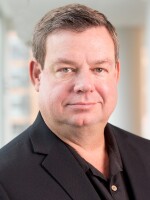DAVID GREENE, HOST:
If 60 is the new 50 and 50 the new 40, well, what then is 97? Veteran bird guide Karl Haller is busy redefining what it means to be just shy of a century. He's been counting birds and teaching the art of bird watching at the Hagerman National Wildlife Refuge in North Texas for over 50 years.
His student this time: NPR's Wade Goodwyn.
WADE GOODWYN, BYLINE: A cool breeze is blowing off Lake Texoma and into the Hagerman National Wildlife Refuge.
(LAUGHTER)
KARL HALLER: Well, it could be. Yeah. We'd only...
GOODWYN: In its mercy, a summer cool front has reached down from Canada across the Midwest, and made it all the way to North Texas.
HALLER: How much rain did you get?
UNIDENTIFIED MAN #1: Half an inch.
HALLER: Oh. Well, I got a little bit more.
GOODWYN: It's 8 AM and Karl Haller and his team of birders hang around a big white van sharing a dozen donuts. Austin College Professors Sandy Beach and Wayne Meyer, along with veteran birders Dick Malnory and Jack Chiles, have been meeting Haller here every Tuesday for more than 30 years. But Haller himself has been chronicling the life of birds since he was a young boy in West Virginia in the early 1920s. Purple martins got him going.
Through coke bottle glasses, Karl's eyes are huge and bright, and he's itching to get going.
HALLER: It's hard to say, you never know what you're going to see. Well, maybe a few ducks will be in, shorebirds - shorebirds, meaning sandpipers, hawks. And then the normal resident summer birds, like painted buntings, indigo buntings and...
GOODWYN: We pile into the van, leftover donuts are passed back to the trunk.
(SOUNDBITE OF IGNITION)
HALLER: All right, folks. Hear we go.
UNIDENTIFIED MAN #2: Can we get the mileage Karl?
HALLER: Oh, yeah. I can't read the damn thing.
(LAUGHTER)
GOODWYN: Ninety-seven years old or not, it's Karl Haller who drives through the refuge - he's still the number one expert after all. But when somebody spots something and wants to look through binoculars, they have to say, Stop Karl, Karl stop.
UNIDENTIFIED MAN #3: Let's count the pelicans Karl.
UNIDENTIFIED MAN #4: Whoa.
UNIDENTIFIED MAN #3: Whoa.
GOODWYN: Haller stomps on the brakes and snaps everyone's head forward. And when I look over I can see a tiny smile. It occurs to me that sometimes Karl hears just fine. He's just messing with his colleagues since he has the steering wheel to hang on to - 97 year old birder humor.
UNIDENTIFIED MAN #5: Where are the ducks?
UNIDENTIFIED MAN #6: They're in the grass in the smart weed.
HALLER: What? One o'clock, three o'clock?
UNIDENTIFIED MAN #6: The tail of one looked like it was a mallard. But I didn't see the other one well enough. OK, Karl.
HALLER: OK.
GOODWYN: It's beautiful here. The vast Lake Texoma creates acres of marshes and wetlands, the birds frolic in the water and grass. But, of course, this is Texas so there's got to be some element of nuttiness.
(SOUNDBITE OF PUMP JACKS)
GOODWYN: Off in the distance can be seen dozens of giant seesaws - up and down, up and down. They're pump jacks, 200 of them, all over the refuge pumping millions of barrels of oil and millions of cubic feet of natural gas. Don't ask.
(SOUNDBITE OF PUMP JACKS AND BIRDS)
GOODWYN: Away from the oil rigs, Karl Haller steps out of the truck, cocks his head and listens.
HALLER: Right out there it looks like a great egret, the white one. And I hear Dickcissels and red wing black birds. Of course I don't hear to well, so I'm probably missing some of the smaller things.
GOODWYN: Haller says what keeps him coming back is his love of birding, his friendships with his colleagues and the fact that even after 97 years, identifying birds still gets him going.
HALLER: Lot's of times the birds are difficult to identify. If you get lots and lots of experience, then you're able to do much better. And you can pick out things that identify the bird. And it's a challenge, really. Mm-hmm.
GOODWYN: Haller says there aren't as many birds as there used to be. He blames it on the explosion of human population in the region. Decade after decade, bearing witness to birdlife decline, has made him philosophical.
HALLER: Well, this is just the way life is and you have to live with it. We'd like to have more of them. But unfortunately this is just the way life's going. Uh-huh, yeah.
GOODWYN: Pulling back up to the refuge headquarters in their van, Jack Chiles catalogues their days work.
JACK CHILES: Forty-seven Canada goose, two mallards, 10 (unintelligible), 10 (unintelligible), Two American white pelicans, seven great blue herons, 23 great egrets, seven snowy egrets, seven little blue herons...
GOODWYN: All this information is entered into the national database at Cornell University. As the day's light begins to fade a reporter asks one last silly question.
Are you going to keep going?
HALLER: As long as I can, sure.
(LAUGHTER)
HALLER: Yeah, I don't know.
GOODWYN: The Republican from Ohio, Warren G. Harding was president when Karl Haller first became a citizen scientist and started watching the world through a pair of binoculars. He even discovered a new species of warbler in 1939 and was given the honor of naming it. Could be he'll still be plugging away at the wildlife refuge when the next president finishes his term too.
UNIDENTIFIED MAN #6: Kill it, Karl.
HALLER: Oh, the motor. Yeah. Just say shut if off or kill it or something like that.
GOODWYN: Wade Goodwyn, NPR News, Dallas. Transcript provided by NPR, Copyright NPR.


